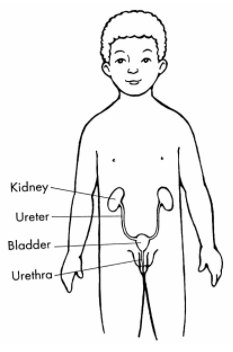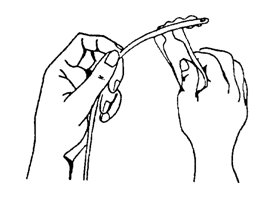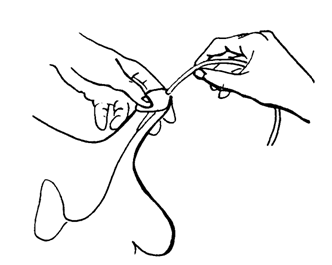Catheterizing a boy - intermittent
Article Translations: (Spanish)
What is intermittent catheterization?
The body holds urine in the bladder, a muscular sac, and empties it through the urethra (yu-reeth-rah), a narrow passageway leading outside the body. A small tube called a catheter (kath-eh-tur) can be inserted through the urethra to help drain the urine. When this is done periodically, it is called "intermittent catheterization" (kath-eh-tur-ah-zay-shun).
Catheterization promotes regular urine flow, protecting against overdistension (overfilling of the bladder). It also helps prevent infection.

Special instructions
Empty your child's bladder ______ times during the day, including upon awakening in the morning and just before bedtime.
Also empty your child's bladder ______ times at night, if directed by the doctor.
Your child's catheter size is ____________
You can buy catheters from _______________________________________
Check with your insurance company for coverage.
What equipment do I need?
___ latex-free catheters (proper size)
___ lubricant (water soluble jelly-like substance used to prevent irritation such as K-Y® jelly. Never use a petroleum- based product such as Vaseline® )
___ clean container to carry catheters such as:
- re-sealable plastic bag
- plastic toothbrush case
- plastic soap case
- any easy-to-carry, tightly covered container
___ container to empty urine into
___ tightly covered container for storing clean, dry catheters at home
For catheterizing while away from home you will also need:
___ re-sealable plastic bag for used catheters
___ pre-moistened antibacterial towelettes
How is catheterization done?
- Clean your hands well, using one of the following methods:
• Use an alcohol hand sanitizer (Purell® or another brand) according to directions.
• If hands are dirty or alcohol is not available, wash your hands with soap and water for at least 15 seconds, rubbing all surfaces briskly, including under fingernails. Use a paper towel or clean hand towel to dry your hands, and then use the towel to turn off the faucet. - Gather equipment (see checklist).
- If the child is toilet trained, ask him to try to urinate.
- Pull back the foreskin (a fold of skin covering the tip of the penis) if present, and wash tip of the penis with soap and water. Use a circular motion starting at the urethra opening and working outward. Use pre-moistened towelettes if soap and water are not available.
- Have your child lie down on his back with his legs extended. If he shows interest in catheterizing himself, he can sit on the toilet or a chair.
- Open the catheter container and remove one catheter without touching the tip.
- Lubricate the catheter tip.

- Hold the penis straight up. Push back the foreskin, if present.

- Hold catheter about 2 inches from the tip. Insert the catheter gently until urine begins to flow into the container or toilet, then advance about ½ inch further.
- Hold the catheter in place until the urine stops flowing.
- When the urine stops flowing, remove the catheter slowly, pausing if the urine starts to flow again.
- Return the foreskin, if present, to the original position.
- Discard the urine and rinse the container well.
How do I care for the equipment?
- Clean catheters right after use with soap and water, using soap lather and your hands.
- Rinse inside and outside of the catheter well with water.
- Air-dry the catheter by laying it on a clean towel.
- Change the towel every day.
- Wash the urine container every day with soap and water.
__ If directed by your child's doctor, sterilize the catheters once a day:
- Clean the catheters as above with soap and water.
- Prepare a solution of 1 teaspoon liquid bleach to 8 ounces water in a clean, tightly covered container. Use a pure, fragrance-free and additive- free bleach, such as Hilex® or Clorox®. Prepare a new solution every day.
- Soak catheters in the bleach solution for at least 30 to 60 minutes.
- After soaking, rinse well with water and air dry on a clean towel.
Throw a catheter away when it becomes stiff or cracked, you are unable to clean it, or after 1 month of use, unless otherwise instructed.
When away from home
If soap and water are not available, use pre- moistened antibacterial towelettes for cleaning hands, the tip of the penis, and catheter.
Urine may be drained into a toilet or into a clean diaper.
If water is available, rinse the catheter after use and place in a re-sealable bag.
Throw away the re-sealable bag after the catheter has been cleaned at home.
When should I call the doctor?
Call the doctor right away if:
- temperature higher than 101°F (38.4°C)
- trouble inserting the catheter
- unusual discomfort while inserting the catheter
- unusual drainage from the penis or around the catheter
- change in the smell of urine
- blood in urine
- cloudy urine
- sandy particles in urine
- decreased amount of urine
Questions?
This is not specific to your child, but provides general information. If you have any questions please call the clinic.
Reviewed 7/2017
This page is not specific to your child, but provides general information on the topic above. If you have any questions, please call your clinic. For more reading material about this and other health topics, please call or visit Children's Minnesota Family Resource Center library, or visit www.childrensmn.org/educationmaterials.
© 2024 Children's Minnesota
